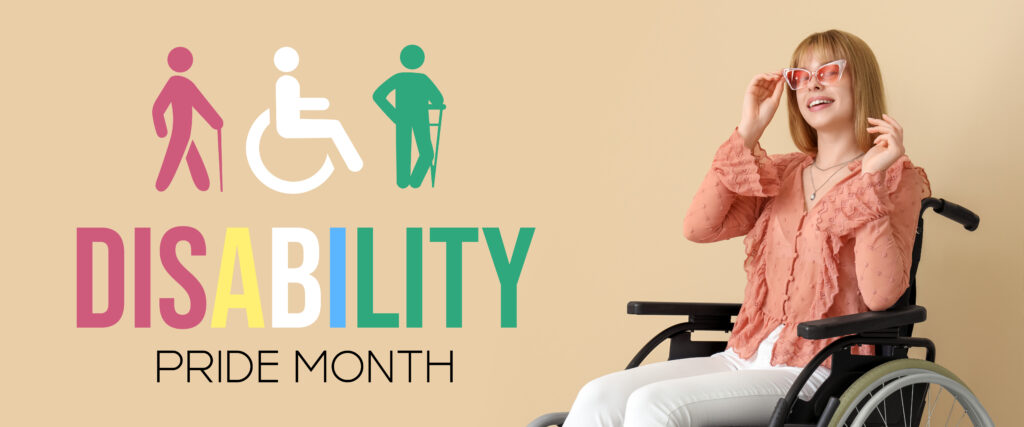Disability Pride Month is an annual awareness day celebrated every July, championing the creativity, resilience, and achievements of disabled people.
The origins of Disability Pride as a celebration go as far back as the passing of the Americans with Disabilities Act back in 1990, which the date traditionally commemorates. However, despite the event’s storied history and enduring relevance to the lives of at least 15% of the world’s population (around 1.3 billion people), it is highly likely that you had never heard of the day until you clicked on this blog, or if not through us via the social media of a similar organisation whose operations centre on disability rights or advocacy.
So why is that exactly? Our team at Direct Access believes that multiple factors contribute to the unawareness of Disability Pride. For one, it has become (rightfully) normalised in the corporate world to celebrate LGBTQ+ communities the month prior in June – which accounts for a lot of celebration efforts for companies during the summer. During this time, companies will typically alter their marketing strategy to show support towards these communities by including Pride colours in their products and advertising, which in turn raises awareness for the experience of this group, and has an overall positive impact on people’s understanding and perception of sexual and gender identities.
A contrastingly more cynical benefit to the adoption of this advocacy, however, is that by including minority groups such as the LGBTQ+ community in their marketing, companies broaden the appeal of their products and services to a wider audience. But either way, both parties ultimately benefit from this relationship.
Right now, you might be wondering why this formula of advocacy for a minority group and corporate advertising is rarely (if ever) adopted for disabled communities. Well, the answer is definitely not due to a lack of monetary benefit. In the UK, we even have a term for the commercial opportunities that catering to a disabled audience facilitates; The Purple Pound, which refers to the 249 billion pounds worth of capital that disabled people across the country carry as disposable income. Despite its well-documented existence, few companies attempt to tap into the disabled market or are even aware of the potential, instead choosing to focus on other minority groups.
Okay. So if it’s not for simple monetary reasons, then why is it that Disability Pride Month and other disability awareness days like it are so often ignored? Why is it that we rarely encounter disabled people in advertising, entertainment, and in the public eye?
The answer for the complete invisibility of disabled people and our lives, our struggles, our stories, ultimately comes down to one very simple thing; a complete lack of awareness. This is why you only ever see disability advocates (like Direct Access) post about disability awareness days – because public discourse has not caught up to our experience of society for a variety of complicated social and economic reasons that cannot be summarised in one blog. However, even though there are multiple reasons why, that does not make our invisibility any less unjust.
For this reason, Disability Pride Month remains an important date in the calendar for our team annually. Every year, we spend countless days, weeks, months, to improve the lives of disabled people, innovating strategies beyond what outdated legislation like the Americans with Disabilities Act considers the baseline for accessibility. Though Disability Pride Month was originally conceived to celebrate this important piece of legislation, it is our inability as a society to move on from old cultural readings of disability and truly understand what it means to be a disabled person on a fundamental level; a difference, that is keeping events like Disability Pride Month in relative obscurity.
So the question remains; what can we do to change the reality that Disability Pride Month comes and goes every year without wide celebration?
Well, the answer to that is also complicated. On an individual level, engaging with content that encourages disability awareness, such as disabled creators on social media platforms, certainly doesn’t hurt in generating awareness. However, if you yourself are disabled, embracing your identity and rejecting negative attitudes that hold us back is another reliable option.
Additionally, if a place you go to or want to go is inaccessible, make that fact known and speak truth to power – because if there’s one thing we at Direct Access understand as accessibility consultants, is that business owners (and in turn wider society) will begin to care about accessibility when enough voices are speaking up about it. It’s the root of what we do, and we are only getting better at it as time goes on.

In truth, this blog probably could have been a bit more positive, considering the topic – but the brutal truth is that Disability Pride as a concept only really exists because we have yet to succeed in creating a fully accepting and inclusive society for disabled people. Indeed, hiding the uncomfortable and difficult parts of being disabled, and ignoring the injustices that continue to affect disabled people like prejudice and downright discrimination, is what has ultimately led to a perpetual lack of understanding of disabled people’s experiences, regardless of the specific time of year.
But by raising awareness of our particular lived experiences, in July and every other calendar month; Disability Pride will eventually become a universally accepted notion within every facet of our society. Awareness of our experience will grow into understanding, and that understanding will blossom into acceptance.